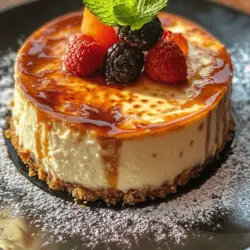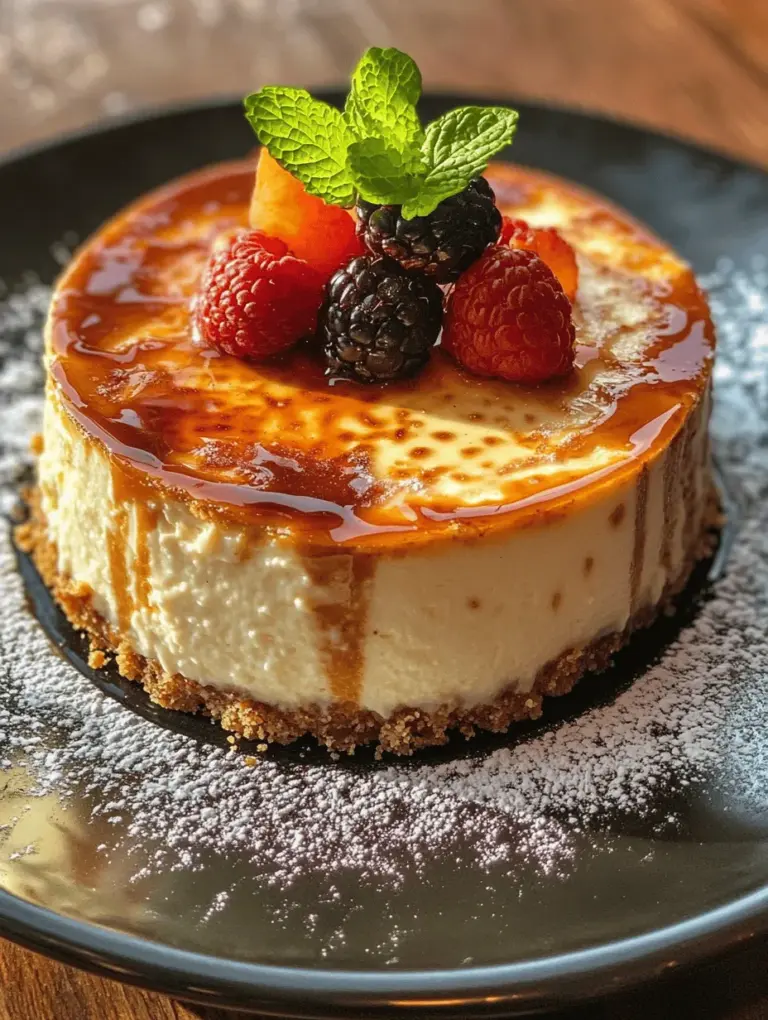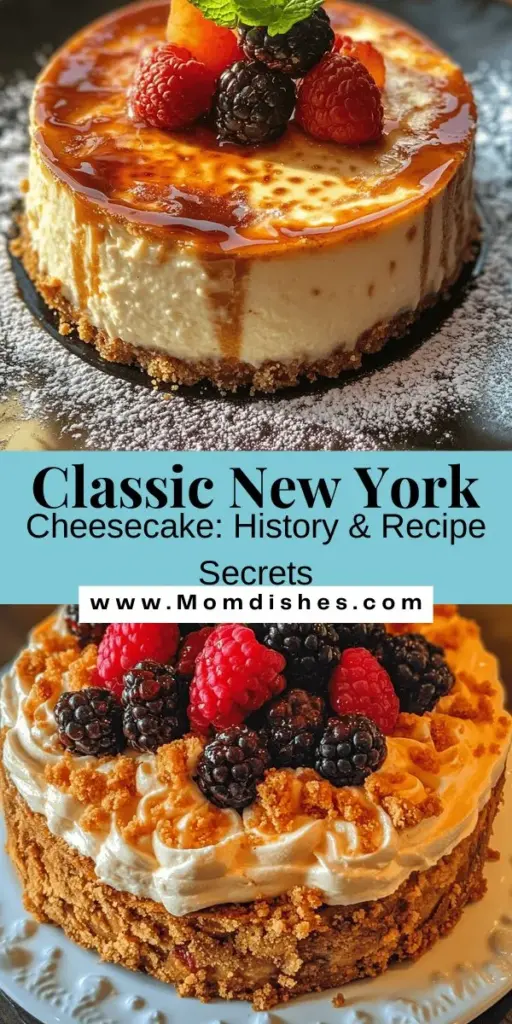Introduction
New York Cheesecake is not just a dessert; it is a culinary icon that has captured the hearts and palates of dessert lovers around the world. Known for its rich, creamy texture and dense flavor, this cheesecake stands apart with its unique characteristics and traditional preparation methods. The classic New York Cheesecake is a delightful balance of sweetness and tanginess, making it a beloved choice for celebrations and special occasions.
Historical Significance and Cultural Impact
The origins of New York Cheesecake can be traced back to the early 1900s, when Jewish immigrants brought their cheesecake recipes to the United States. Over time, the recipe evolved, eventually leading to the rich and creamy version we know today. It gained immense popularity in New York City, particularly in the bustling borough of Manhattan, where delis and bakeries showcased this decadent dessert.
New York Cheesecake is more than just a treat; it reflects a blend of cultures and the innovation of American cuisine. Its prominence in American culture is evident in its appearances in films, television shows, and even literature, where it often symbolizes indulgence and celebration. Whether served plain, topped with fresh fruit or decadent chocolate, this cheesecake represents a slice of New York’s vibrant food scene.
Creamy Texture and Rich Flavor
What sets the classic New York Cheesecake apart is its incredibly smooth and dense texture. Unlike other cheesecakes that may be light and airy, this version is characterized by its velvety creaminess that melts in your mouth. The rich flavors come from a perfect combination of cream cheese, eggs, and other quality ingredients, creating a dessert that is both satisfying and indulgent.
Importance of Using Quality Ingredients
When it comes to making the perfect New York Cheesecake, the quality of your ingredients can significantly impact the final product. Unlike many desserts, which may tolerate substitutions or lower-quality ingredients, cheesecake demands the best in order to achieve that signature taste and texture. Using high-quality cream cheese, fresh eggs, and premium butter will not only enhance the flavor but also contribute to the overall consistency of your cheesecake.
How Ingredient Quality Affects the Final Product
Choosing the right ingredients means understanding how each one contributes to the cheesecake’s overall profile. For example, using a higher-fat cream cheese ensures a richer flavor and creamier texture, while fresh eggs provide essential structure and stability during baking. Thus, investing in quality ingredients is key to achieving the perfect New York Cheesecake that rivals those found in the finest New York bakeries.
Overview of the Recipe
Creating a classic New York Cheesecake at home may seem daunting, but with a simple step-by-step approach, you can achieve bakery-quality results. The process involves preparing a buttery graham cracker crust, a smooth and creamy filling, and then baking it to perfection. This recipe will guide you through each essential step, from preheating your oven to serving a slice of this iconic dessert.
Understanding the Ingredients
To achieve the best results when making a classic New York Cheesecake, it’s important to understand the role of each ingredient in the recipe. Below is a breakdown of the fundamental components that contribute to the cheesecake’s delightful flavor and texture.
Graham Cracker Crumbs: Purpose and Alternatives
The crust of a New York Cheesecake is typically made from graham cracker crumbs. These crumbs provide a sweet and slightly nutty flavor that complements the rich filling. To make the crust, simply crush graham crackers into fine crumbs and combine them with melted butter and sugar.
If you want to experiment with alternatives, consider using digestive biscuits or even crushed cookies such as Oreos for a different flavor profile. For a gluten-free version, gluten-free graham cracker crumbs or almond flour mixed with butter can be a suitable substitute.
Granulated Sugar: Sweetness Balance
Granulated sugar is used to sweeten the cheesecake filling and the crust. It balances the tanginess of the cream cheese and sour cream, providing a harmonious flavor. While the standard recipe calls for granulated sugar, you may also explore alternatives like brown sugar for a hint of caramel flavor or coconut sugar for a lower glycemic index option. However, ensure that any substitutions maintain the required sweetness level.
Unsalted Butter: Importance of Unsalted Versus Salted
When it comes to baking, unsalted butter is the preferred choice. This allows you to control the amount of salt in your cheesecake and ensures that the flavors remain balanced. Unsalted butter contributes to a rich, creamy texture in the crust, and it is essential for achieving the desired consistency. If you only have salted butter on hand, you can use it, but reduce the added salt in the recipe accordingly.
Cream Cheese: Types and How to Choose the Best for Cheesecake
Cream cheese is the star ingredient in any cheesecake, and selecting the right type is crucial. Look for full-fat cream cheese, as it provides the rich, creamy texture that is characteristic of New York Cheesecake. Brands like Philadelphia are widely recognized for their quality, but always check the ingredient list for any stabilizers or additives that may affect the taste.
Avoid using low-fat or whipped cream cheese, as these tend to be too light and may not yield the desired density. Room temperature cream cheese is essential for a smooth batter, so make sure to take it out of the refrigerator at least an hour before you start mixing.
Sour Cream: Its Role in Texture and Flavor
Sour cream is another key ingredient that contributes to the cheesecake’s creamy texture and tangy flavor. It adds moisture and richness, making the filling smooth and luscious. You may also substitute sour cream with Greek yogurt for a slightly healthier option, but ensure it is full-fat for the best results.
Eggs: Function in the Baking Process
Eggs serve as a binding agent in the cheesecake filling, providing structure and stability. They also contribute to the creamy texture and help the cheesecake set properly during baking. For the best results, use large eggs at room temperature, as they incorporate more easily into the batter.
Lemon Juice: Enhancing Flavor Profile
A splash of fresh lemon juice adds brightness and depth to the cheesecake, balancing the richness of the cream cheese and sour cream. It also enhances the overall flavor profile, making every bite more enjoyable. Always opt for fresh lemon juice instead of bottled, as the flavor is more vibrant and natural.
Optional Flour: Discussing the Benefits for Stability
While not always included, a small amount of all-purpose flour can be added to the cheesecake filling to provide extra stability. This can help prevent cracks during baking and ensure a smooth, even texture. If you decide to include flour, be sure to sift it before adding it to the mixture to avoid lumps.
Preparation Steps for Classic New York Cheesecake
Once you have gathered all your high-quality ingredients, it’s time to start preparing your classic New York Cheesecake. Here are the initial steps to follow:
Preheating the Oven
The first step in any baking process is to preheat your oven to the correct temperature. For a New York Cheesecake, you will want to set your oven to 325°F (160°C). Proper oven temperature is crucial as it ensures even baking, which helps prevent cracks and maintains the creamy texture of the cheesecake.
Preparing the Crust
To prepare the graham cracker crust, begin by crushing the graham crackers into fine crumbs using a food processor or by placing them in a zip-top bag and rolling them with a rolling pin. Once you have your crumbs, transfer them to a mixing bowl and add granulated sugar and melted unsalted butter.
Mix the ingredients together until the crumbs are well coated and resemble wet sand. The mixture should hold together when pressed.
Tips for Achieving the Perfect Crust Texture:
– Ensure that the butter is fully melted before mixing it with the crumbs, as this helps to bind the crust together.
– Press the crumb mixture firmly into the bottom of a springform pan to create an even base. Use the back of a measuring cup or your fingers to achieve a compact crust.
– For added texture, you can bake the crust for 10 minutes before adding the filling, allowing it to crisp up slightly.
Baking the Crust
Once your crust is ready, it’s time to bake it. Place the springform pan in the preheated oven and let it bake for about 10 minutes. You’ll know the crust is done when it is lightly golden and fragrant.
After baking, remove the crust from the oven and allow it to cool slightly while you prepare the cheesecake filling. This step is essential, as a warm crust may cause the filling to overheat and blend poorly.
Creating the Cheesecake Filling
The next step in your cheesecake-making journey is to create the filling. Begin by ensuring that your cream cheese, sour cream, and eggs are at room temperature. This is a crucial factor in attaining a smooth batter that is free from lumps.
In a large mixing bowl, beat the room-temperature cream cheese until it is smooth and creamy. Gradually add the granulated sugar, mixing until fully combined. This process helps to break down the sugar and ensures that it incorporates well into the cream cheese.
Once the sugar is fully blended, add in the sour cream, lemon juice, and any optional flour. Mix until the ingredients are combined and the mixture is smooth. Finally, add the eggs one at a time, mixing gently after each addition. Be careful not to overbeat the eggs, as this can introduce too much air into the batter, leading to cracks during baking.
By following these steps carefully, you will be well on your way to creating a classic New York Cheesecake that is sure to impress your family and friends. The next section will delve into the final steps of baking and cooling your cheesecake, ensuring that every slice is perfect.
Stay tuned for more details on how to complete this delectable dessert!
{{image_1}}
Step-by-Step Guide to Mixing and Incorporating Ingredients
Once you have prepared your crust, the next step is to create the creamy filling that will make your New York cheesecake a standout dessert. Begin by taking your softened cream cheese and placing it in a large mixing bowl. Using an electric mixer on medium speed, beat the cream cheese until it’s smooth and free of lumps, which should take about 2-3 minutes. This step is crucial, as any lumps will carry through to the final texture of the cheesecake, giving it an undesirable graininess.
Next, gradually add in the granulated sugar, mixing well until fully combined and creamy. The sugar should dissolve completely into the cream cheese, so continue mixing for another 1-2 minutes. Then, add in the sour cream and vanilla extract. Mix on low speed just until blended. Finally, incorporate the eggs one at a time, mixing on low speed after each addition. Be careful not to overmix at this stage, as too much air can lead to cracks while baking. Aim for a smooth, homogenous mixture, ensuring that all ingredients are well incorporated.
Pouring and Baking the Cheesecake
With your filling ready, it’s time to pour it into the prepared crust. To do this without compromising your crust, consider using a spatula to gently pour the filling in the center of the crust and spread it outward. This technique minimizes disruption to the crust, ensuring it remains intact.
Once the filling is evenly poured, it’s time to bake. Preheat your oven to 325°F (160°C), and place your cheesecake on the middle rack. It’s highly recommended to bake your cheesecake in a water bath (bain-marie) to maintain moisture and even temperature. To create a water bath, wrap the outside of your springform pan with aluminum foil to prevent water from seeping in. Place the pan in a larger baking dish and fill it halfway with hot water.
Bake the cheesecake for 60-70 minutes. The edges should be set, while the center remains slightly jiggly. Overbaking is a common pitfall that can lead to cracks, so it’s essential to monitor it closely as it approaches the end of the baking time.
Baking Tips to Avoid Common Pitfalls
To ensure your cheesecake bakes perfectly, here are some tips to avoid common issues:
– Overbaking: Keep an eye on the cheesecake during the last 15 minutes of baking. If you notice the edges are firm but the center is still wobbly, it’s a good sign that it’s done.
– Cracking: Cracks can form due to sudden temperature changes. To prevent this, avoid opening the oven door during the baking process. Additionally, allow your cheesecake to cool gradually in the oven with the door ajar for about an hour after baking.
Cooling and Chilling Techniques
Once your cheesecake is baked, cooling is an essential step. Start by letting the cheesecake cool in the oven for about an hour with the door slightly ajar. This gradual cooling helps to prevent cracking. After the hour is up, remove the cheesecake from the water bath and let it cool at room temperature for another hour.
Once cooled, cover the cheesecake with plastic wrap or foil and place it in the refrigerator. It’s best to chill your cheesecake for at least 4 hours, but overnight is ideal. This chilling time allows the flavors to meld and the texture to set, resulting in that classic creamy consistency we all love.
Serving Your Classic New York Cheesecake
Presentation Tips
When it’s time to serve your cheesecake, presentation is key. Remove the sides of the springform pan carefully, and place the cheesecake on a serving platter. To elevate your presentation, consider garnishing with fresh berries such as strawberries, blueberries, or raspberries. A few sprigs of mint can also add a pop of color and freshness.
Suggestions for Garnishing with Fresh Berries and Mint
For a delightful twist, create a berry compote by cooking fresh or frozen berries with a little sugar until they form a syrupy sauce. Drizzle this over each slice of cheesecake before serving for added flavor and visual appeal.
Slicing and Serving Recommendations
When slicing your cheesecake, it’s essential to use a sharp, long knife to achieve clean cuts. To prevent sticking, dip your knife in hot water and wipe it dry before each slice. This technique ensures that each piece retains its shape and looks appealing on the plate.
Pairing Suggestions
Pair your cheesecake with complementary flavors by serving it alongside sauces like chocolate ganache or caramel. For beverages, consider serving a rich coffee, espresso, or a dessert wine, which can enhance the experience of indulging in this classic treat.
Troubleshooting Common Issues
Addressing Common Cheesecake Problems
Even the best bakers encounter issues from time to time. Here are some common problems and solutions to help you troubleshoot:
– Cracking: Cracks can be caused by overmixing the batter or rapid temperature changes. To prevent this, use room temperature ingredients and bake at a steady temperature with minimal disturbance.
– Overbaking: Signs of overbaking include a dry texture and a darkened top. Always check for doneness before the suggested baking time and rely on the jiggle test for the center.
– Underbaking: If your cheesecake appears too soft or runny in the center, it may need additional baking time. Return it to the oven in small increments until it firms up slightly.
Variations and Customizations
For those looking to experiment with flavors, consider creating variations of the classic New York cheesecake. By adding ingredients such as melted chocolate, fruit purees, or spices like cinnamon or nutmeg, you can create unique flavored cheesecakes that cater to different tastes. Adjusting the sweetness can also allow for a more personalized dessert experience.
Nutritional Information
When indulging in a classic New York cheesecake, it’s helpful to be aware of the nutritional values. A standard slice (approximately 1/12 of the cheesecake) contains around 400-500 calories, with about 30% of those calories coming from fat. Typical values include:
– Calories: 450
– Total Fat: 30g
– Saturated Fat: 18g
– Sugars: 25g
– Protein: 6g
While cheesecake is undoubtedly an indulgence, moderation is key. Enjoy this rich dessert as a special treat rather than an everyday option.
Conclusion
The classic New York cheesecake is not just a dessert; it’s a celebration of flavors and textures that captures the essence of baking. From the buttery graham cracker crust to the creamy, decadent filling, each bite is a reminder of the joy of homemade treats. By following the steps outlined in this recipe, anyone can master the art of creating this beloved dish from scratch.
So gather your ingredients, don your apron, and embark on a delightful baking adventure. You might just find that the satisfaction of making your own cheesecake at home is as sweet as the dessert itself. Don’t hesitate to share your creation with family and friends, and enjoy the admiration that follows. Happy baking!


